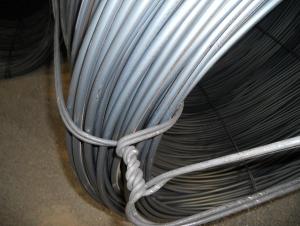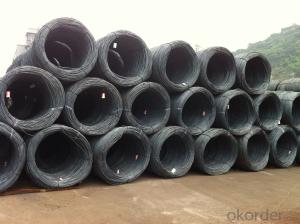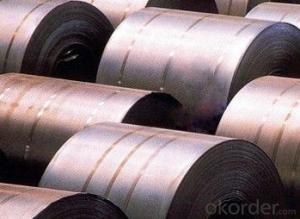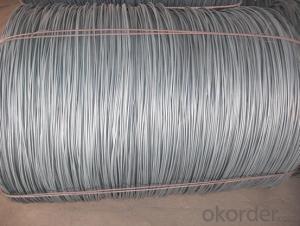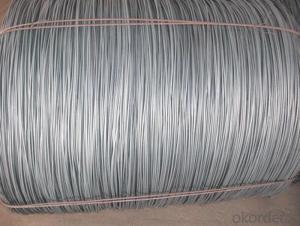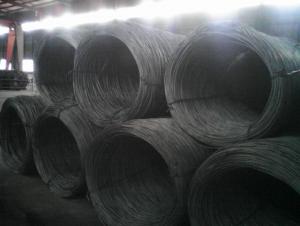Hot Rolled Low Carbon Steel Wire Rods for Nails, Steel Wire Mesh
- Loading Port:
- Tianjin
- Payment Terms:
- TT or LC
- Min Order Qty:
- 25 m.t.
- Supply Capability:
- 100000 m.t./month
OKorder Service Pledge
OKorder Financial Service
You Might Also Like
Product Description:
OKorder is offering Hot Rolled Low Carbon Steel Wire Rods for Nails, Steel Wire Mesh at great prices with worldwide shipping. Our supplier is a world-class manufacturer of steel, with our products utilized the world over. OKorder annually supplies products to African, South American and Asian markets. We provide quotations within 24 hours of receiving an inquiry and guarantee competitive prices.
Product Applications:
Hot Rolled Low Carbon Steel Wire Rods for Nails, Steel Wire Mesh are ideal for structural applications and are widely used in construction and manufacturing. Carbon steel wire rod is mainly used for reinforcement of reinforced concrete and welded structure or reprocessed (roberts , nail, etc.) materials, especially used to produce wire drawing, welding electrode, nails, spring, electronic, precise machinery parts and so on.
Product Advantages:
OKorder's Hot Rolled Low Carbon Steel Wire Rods for Nails, Steel Wire Mesh are durable, strong, and wide variety of sizes. They are newly produced by good quality steel billets.
Main Product Features:
· Premium quality
· Prompt delivery & seaworthy packing (30 days after receiving deposit)
· Can be recycled and reused
· Mill test certification
· Professional Service
· Competitive pricing
Product Specifications:
Steel Grade: SAE1006-1018B
Standard: ASTM, GB
Diameter: 5.5mm, 6.5mm, 7mm,8mm,9mm,10mm,12mm,14mm
Type: in coil, coil weight around 2MT
Alloy or Not: Alloy
Technique: Hot Rolled
Place of Origin: China Mainland
Surface: round, no twisted, light and smooth
FAQ:
Q1: Why buy Hot Rolled Low Carbon Steel Wire Rods for Nails, Steel Wire Mesh from OKorder.com?
A1: All products offered byOKorder.com are carefully selected from China's most reliable manufacturing enterprises. Through its ISO certifications, OKorder.com adheres to the highest standards and a commitment to supply chain safety and customer satisfaction.
Q2: How do we guarantee the quality of our products?
A2: We have established an advanced quality management system which conducts strict quality tests at every step, from raw materials to the final product. At the same time, we provide extensive follow-up service assurances as required.
Q3: How soon can we receive the product after purchase?
A3: Within three days of placing an order, we will arrange production. The normal sizes with the normal grade can be produced within one month. The specific shipping date is dependent upon international and government factors, the delivery to international main port about 45-60days.
Images:
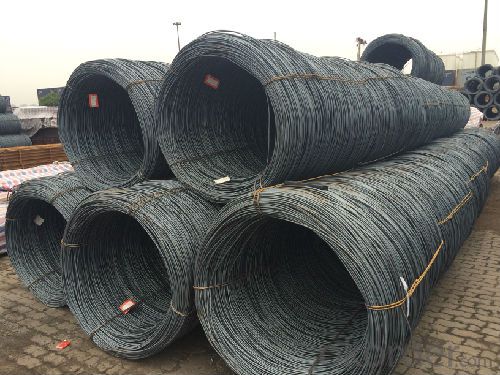

- Q:How is steel wire rod used in the production of wire mesh?
- Steel wire rod is an essential component in the production of wire mesh. Wire mesh, also known as wire cloth or wire fabric, is a versatile material that is used in various industries for different purposes. The production of wire mesh begins with the manufacturing of steel wire rod. Steel wire rod is produced through a process called hot rolling, where molten steel is passed through a series of rollers to form a long, continuous rod with a specific diameter. The diameter of the steel wire rod can vary depending on the desired end product and application of the wire mesh. Once the steel wire rod is produced, it is then drawn through a series of dies to reduce its diameter further. Drawing the wire rod through these dies not only reduces its diameter but also improves its tensile strength and surface finish. This drawn wire is now ready to be used in the production of wire mesh. The steel wire rod is fed into a wire mesh machine, where it goes through a series of processes to form the wire mesh. The wire is first straightened and then cut into the desired length. These cut lengths of wire are then fed into a weaving machine, where they are interwoven to form the mesh pattern. The wire mesh machine uses various techniques to create different types of wire mesh, such as plain weave, twill weave, or Dutch weave. The steel wire rod acts as the building blocks for these patterns, providing the strength and durability needed for the wire mesh to withstand various applications. Once the wire mesh is woven, it undergoes further processes, such as galvanizing or coating, to enhance its properties. Galvanizing involves coating the wire mesh with a layer of zinc to protect it from corrosion, while coating can provide additional properties like resistance to heat, chemicals, or abrasion. In summary, steel wire rod is a crucial material in the production of wire mesh. It is used as the starting material, which is then processed and woven to create various types of wire mesh patterns. The steel wire rod provides the necessary strength and durability for the wire mesh to be used in different industries and applications.
- Q:How is the microstructure of steel wire rod analyzed?
- The microstructure of steel wire rod is typically analyzed using various techniques such as optical microscopy, electron microscopy (scanning electron microscopy or transmission electron microscopy), and X-ray diffraction. These techniques allow for the examination of the grain structure, inclusion content, and other microstructural features of the steel wire rod.
- Q:How are steel wire rods used in the manufacturing of mesh screens for filtration and separation?
- Steel wire rods are an essential component in the manufacturing process of mesh screens for filtration and separation. These wire rods, typically made of high-quality stainless steel, are used to create the mesh structure of the screens. Firstly, the steel wire rods are subjected to a series of processes such as drawing, annealing, and surface treatment to enhance their mechanical properties and corrosion resistance. This ensures that the resulting mesh screens are durable and can withstand harsh operating conditions. Next, the wire rods are fed into a specialized machine called a wire mesh weaving loom. This machine weaves the individual wires together in a crisscross pattern, creating a tightly-knit mesh. The size and spacing of the mesh can be customized depending on the specific filtration or separation requirements. The woven mesh is then inspected for defects and trimmed to the desired dimensions, ensuring a uniform and precise screen. In some cases, additional processes such as heat treatment or coating may be applied to further enhance the performance or functionality of the mesh screens. Once the mesh screens are ready, they can be used in a wide range of applications for filtration and separation purposes. For example, they can be installed in industrial filtration systems to remove impurities from liquids or gases. They can also be used as sieves or strainers to separate particles of different sizes. The mesh screens provide an effective barrier while allowing the desired substances to pass through, ensuring efficient filtration and separation processes. In summary, steel wire rods play a crucial role in the manufacturing of mesh screens for filtration and separation. They are transformed into woven mesh structures that provide reliable and durable solutions for various industries, ensuring effective filtration and separation of substances based on their specific requirements.
- Q:How is steel wire rod different from steel bars?
- Steel wire rod and steel bars are both made from steel, but they differ in terms of their shape and size. Steel wire rod is a long, thin, and cylindrical product, typically with a diameter ranging from 5.5mm to 20mm. It is primarily used as a raw material in the manufacturing of various steel products, including nails, wires, and reinforcement materials. On the other hand, steel bars are solid, straight, and usually have a larger diameter compared to wire rods. They are commonly used in construction projects as structural components, such as beams, columns, and reinforcing bars in concrete structures. Therefore, the key distinction lies in their shape and application in different industries.
- Q:How is steel wire rod used in the manufacturing of wire forms for power transmission systems?
- Steel wire rod is used in the manufacturing of wire forms for power transmission systems as it serves as the raw material for creating strong and durable wires. These wires are then used to produce various components like cables, conductors, and connectors that are essential for transmitting electric power efficiently and reliably.
- Q:What are the common applications of low alloy steel wire rod?
- Low alloy steel wire rod has various common applications due to its specific properties and characteristics. Some of the most common applications of low alloy steel wire rod include: 1. Construction industry: Low alloy steel wire rod is widely used in the construction industry for reinforcing concrete structures. It is commonly used to manufacture welded wire mesh, which is used to reinforce concrete slabs, walls, and foundations. The high strength and durability of low alloy steel wire rod make it an ideal choice for withstanding heavy loads and preventing structural failure. 2. Automotive industry: Low alloy steel wire rod is extensively used in the automotive industry for manufacturing various components. It is commonly used to produce springs, suspension systems, and other high-stress components that require excellent strength and fatigue resistance. The low alloy steel wire rod's ability to withstand heavy loads and constant stress makes it well-suited for automotive applications. 3. Manufacturing industry: Low alloy steel wire rod is also used in various manufacturing processes. It is commonly employed in the production of fasteners, such as screws, bolts, and nuts, due to its high tensile strength. Additionally, low alloy steel wire rod is used for manufacturing wire ropes, cables, and other high-strength wire products that require durability and resistance to corrosion. 4. Engineering industry: Low alloy steel wire rod finds applications in the engineering industry for fabricating structural components, machinery parts, and equipment. It is often used for manufacturing gears, shafts, and bearings due to its excellent wear resistance and ability to withstand heavy loads. The low alloy steel wire rod's properties make it a reliable choice for critical engineering applications. 5. Electrical industry: Low alloy steel wire rod is used in the electrical industry for manufacturing various electrical conductors and components. It is commonly used to produce overhead power lines, electrical cables, and wires due to its high electrical conductivity and mechanical strength. The low alloy steel wire rod's ability to carry electricity efficiently and its resistance to mechanical stress make it suitable for electrical applications. In summary, low alloy steel wire rod has a wide range of applications in the construction, automotive, manufacturing, engineering, and electrical industries. Its high strength, durability, wear resistance, and electrical conductivity make it a versatile material for various applications that require reliability and performance.
- Q:What are the main factors affecting the market forecasts of steel wire rod?
- The main factors affecting the market forecasts of steel wire rod include global economic conditions, demand and supply dynamics, raw material prices, government policies and regulations, technological advancements, competition within the industry, and geopolitical factors.
- Q:How is steel wire rod used in the production of wire mesh sieves?
- Steel wire rod is used in the production of wire mesh sieves as it serves as the primary material for creating the mesh structure. The wire rod is first drawn through a series of dies to reduce its diameter and increase its length, resulting in a long, thin wire. This wire is then woven or welded together to form the mesh pattern, which is subsequently stretched and shaped into the desired sieve shape. The strength and durability of the steel wire rod ensure that the wire mesh sieves can withstand rigorous usage, making them suitable for various industrial applications such as filtration and particle size analysis.
- Q:What are the different types of coatings used on steel wire rod?
- There are various types of coatings used on steel wire rods, each serving a specific purpose and providing unique benefits. Some common types of coatings include: 1. Zinc Coating: Zinc is one of the most widely used coatings for steel wire rods. It provides excellent corrosion resistance, acting as a protective barrier between the steel and the surrounding environment. Zinc coatings can be applied through hot-dip galvanizing or electroplating processes. 2. Polymer Coating: Polymer coatings are often applied to steel wire rods to enhance their durability and resistance to abrasion. These coatings can be made from various types of polymers, such as polyethylene or polypropylene, and are often applied through extrusion processes. 3. Phosphate Coating: Phosphate coatings are used to improve the adhesion between the steel wire rod and subsequent coatings or paints. They provide a rough surface that enhances the bonding ability of other coatings, thereby increasing their effectiveness. 4. Epoxy Coating: Epoxy coatings are commonly used for steel wire rods that will be exposed to harsh environments, such as marine or industrial applications. These coatings offer excellent chemical resistance and durability, protecting the steel from corrosion and other forms of degradation. 5. Chrome Coating: Chrome coatings provide a highly polished and decorative finish to steel wire rods. They are often used in applications where aesthetics are important, such as in the manufacturing of furniture or automotive components. 6. Nickel Coating: Nickel coatings are used to enhance the corrosion resistance of steel wire rods in highly corrosive environments, such as marine or chemical processing applications. Nickel coatings can be applied through electroplating processes. 7. Copper Coating: Copper coatings are applied to steel wire rods to improve their electrical conductivity. They are often used in applications where the wire rod will be used for electrical purposes, such as in wiring systems or electronic devices. It is important to note that the choice of coating for a steel wire rod will depend on the specific application and the desired properties of the finished product. Furthermore, some coatings can be combined or modified to achieve specific performance requirements.
- Q:What are the common production processes for xenon-coated steel wire rod?
- The common production processes for xenon-coated steel wire rod include cleaning and pre-treatment, application of the xenon coating through a specialized coating process, curing or drying of the coating, and quality control checks to ensure the coating is applied uniformly and meets required standards.
1. Manufacturer Overview |
|
|---|---|
| Location | |
| Year Established | |
| Annual Output Value | |
| Main Markets | |
| Company Certifications | |
2. Manufacturer Certificates |
|
|---|---|
| a) Certification Name | |
| Range | |
| Reference | |
| Validity Period | |
3. Manufacturer Capability |
|
|---|---|
| a)Trade Capacity | |
| Nearest Port | |
| Export Percentage | |
| No.of Employees in Trade Department | |
| Language Spoken: | |
| b)Factory Information | |
| Factory Size: | |
| No. of Production Lines | |
| Contract Manufacturing | |
| Product Price Range | |
Send your message to us
Hot Rolled Low Carbon Steel Wire Rods for Nails, Steel Wire Mesh
- Loading Port:
- Tianjin
- Payment Terms:
- TT or LC
- Min Order Qty:
- 25 m.t.
- Supply Capability:
- 100000 m.t./month
OKorder Service Pledge
OKorder Financial Service
Similar products
New products
Hot products
Hot Searches
Related keywords

